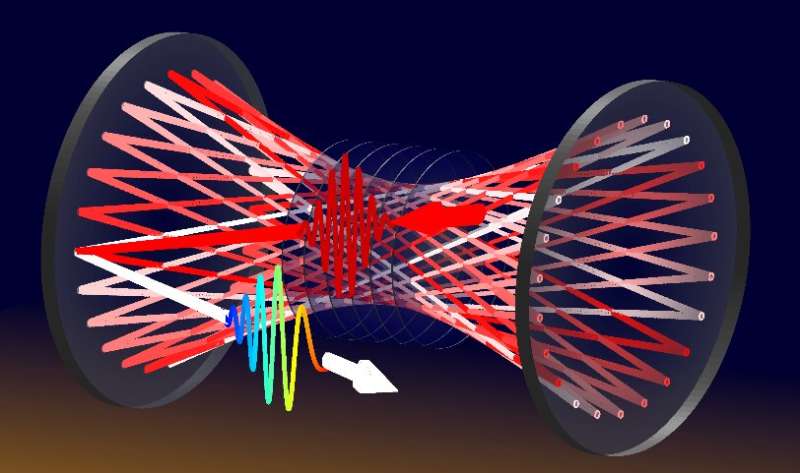A new guide to extremely powerful light pulses

The first demonstration of the laser in 1960 was rapidly followed by the birth of a new research field: nonlinear optics. The unique coherence properties of stimulated emission, the fundamental physical process of laser radiation, has enabled intensities that exceed those of incoherent sources by many orders of magnitude. The high intensities drive electrons so strongly that they oscillate with frequencies different from those of the driving light field. The subsequent dipole emission can be extremely colorful. Optical fiber or laser filaments have been used as waveguides for decades to maximize this effect and to generate extremely broadband light pulses.
However, if the laser pulses carry too much energy, fiber suffers from damage and light filaments break-up, such that the unique spatial properties of laser radiation are lost. Researchers from the German Electron-Synchrotron DESY in Hamburg, Germany, and the Helmholtz-Institute Jena, Germany have now reported a new method for guiding light in an energy-scalable manner. Guiding is accomplished by the use of two refocusing mirrors and the careful spacing of thin nonlinear glass windows.
The scientists have reported in a recent publication in Ultrafast Science that light pulses gain more than 30 times of their initial bandwidth in such a setup and can be consequently compressed by the same factor. This shortens their duration and considerably increases their peak power. Remarkably, these experiments were performed with laser pulses that exceed the peak power limit in glass fibers by a factor of 40. However, despite propagation through about 40 cm of glass in total, beam quality and pulse energy remained high. "We have elegantly combined two recent approaches to extend the bandwidth of ultrashort pulses. Nevertheless, the optical setup is really simple. All optics we used in our spectral broadening scheme were stock items. This and the excellent noise properties make our approach widely applicable," says Dr. Marcus Seidel, lead author of the publication.
Dr. Christoph Heyl, junior group leader at DESY and the Helmholtz Institute Jena, adds that "there is a clear trend in ultrafast laser technology towards high average power sources which can often only deliver pulses with picosecond-level durations. Our method presents an energy-, size- and cost-efficient approach to turn these lasers to pulsed sources with only tens of femtosecond duration with gigawatts of peak power."
The femtosecond regime is the timescale of molecular motion which can be tracked and manipulated with ultrashort pulses. Moreover, femtosecond pulses are too fast to allow heat generation after ionization. This is widely exploited in laser material processing. The pulse compression approach has been used at DESY's free electron laser facility FLASH for several months already. It has enabled scientists to take precise snapshots of molecular dynamics in novel quantum materials.
"Our facility users have been very happy with it," says Dr. Seidel and looks ahead: "We would be delighted, of course, if this technology enables cutting-edge science experiments at DESY and many other institutes around the world."
Dr. Heyl's team has recently published simulations that show the extension of the demonstrated approach to terawatt peak powers and joule-level pulse energies. Implementing such energy-upscaled experiment will open the door to entirely new applications.
"Spectral broadening and pulse compression have been identified as the key methods for advancing strong-field physics by the 2018 Nobel laureate Gérard Mourou," says Dr. Heyl. "With the new technology, his prediction may take shape. We are already setting up a first compact multi-pass cell-based particle accelerator in our laboratories. We expect that the concept also makes an impact on future radiation therapy and possibly even laser-based fusion."
More information: Marcus Seidel et al, Factor 30 Pulse Compression by Hybrid Multipass Multiplate Spectral Broadening, Ultrafast Science (2022). DOI: 10.34133/2022/9754919
Provided by Ultrafast Science





















